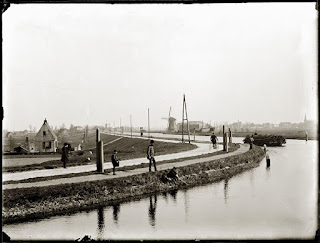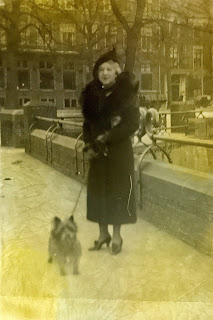The maiden aunt
The maiden aunt Week 14 prompt) sounds more lyrical and romantic than spinster aunt. So I wonder about the origin of these terms. A quick google search brings up the meaning of unmarried woman who has passed the usual age of marriage. The maiden aunt has the extra flavour of prim and proper and to me the spinster has a wrinkled and dried prune look.
Such strong images these words evoke. They don't do justice to the real lives of these woman. In a time that marriage was the only approved "lifestyle" for women, the maiden aunt in the family could well be the one with a remarkable spirit of independance or vocation or could be harboring a tragic love whose promise could not be fullfilled because of war or death.
I consider a few candidates for this post and conclude that really I have no maiden aunts to speak of. Maiden cousins? Yes, there are a couple. So I settle on one who I remember personally and who also left a great contribution in the social housing history of Amsterdam.
Her father and my great grandfather were brothers, Roelof and Jan Blomberg, both primary school teachers, so can't be sure but she'd be something like a first cousin twice removed. I met her when I was about 8 years old and it made a big impression on me. To me she was Tante Mien. I remember her as a jovial, enthusiastic woman, who lived in an apartment on Roelof Hart Plein, Amsterdam, not far from my grandparents' place.
Wilhelmina Carolina (Mien) Blomberg was born in Haarlem on 21 September 1908, in a school teacher's family who were also very involved in social welfare. She obtained her diploma in Social Welfare and in 1935 she joined the NV Bouwonderneming Jordaan (Building Foundation Jordaan) as assistant to Louise Went, the first and only "opzichteres" (supervisor) of this philanthropic enterprise for housing for the poor.
The Jordaan was one of the poorer areas in Amsterdam at the time. The supervisor did more than collect the rent and check the condition of the dwelling. They also educated the workers and their families on how to behave as good tenants. Mien Blomberg's view was that as supervisor one needed to listen to the worker's wives, who were not as emancipated as their more educated sisters. (https://nl.wikipedia.org/wiki/Wilhelmina_Carolina_Blomberg)
Tante Mien went on to become a director of the Amsterdamse Bouw Fonds and the Bouwondernemeing Jordaan after 1945 and continued throughout her working life to champion the housing needs of poor single women, who otherwise only had the option of living as a boarder for the rest of their lives.
She earned a couple of distinctions in her life - in 1968 Ridder (Knight) in the order Oranje-Nassau, and in 1976 she was awarded the gold distinction from the city of Amsterdam.
But probably her most unexpected award was having a "plein", town square named after her. In 1992 the neighbourhood Oranje-Nassau Kazerne was completed. It centred around the old military barracks building, built in 1811, which was heritage listed and now converted to apartments and new homes built in the former exercise grounds.
 |
| Oranje-Nassau Kazerne building (from press cutting in Family Archive |
The council wanted to honour women by naming streets after them and was pleased to list four women distinguished for their work in social housing and women's rights, including Wilhelmina Blomberg. They had overlooked one crucial fact though, Wilhelmina Blomberg was alive and well at the time. So it was agreed that aside from members of the royal family, she was the only other living person who had a public place named after them. (http://www.amsterdamsebinnenstad.nl/binnenstad/200/ricardo.html)
My uncle Cees Blomberg had quite a lot of contact with her in her later years and he writes in his family tree that when they went to visit the Wilhelmina Blomberg Plein to see for themselves, they both felt very proud, but tante Mien thought it also a little over the top (overdreven).
She passed away, aged 88, 4 January, 1997 in Amersfoort.





This comment has been removed by a blog administrator.
ReplyDeleteRemoved in error.
Delete